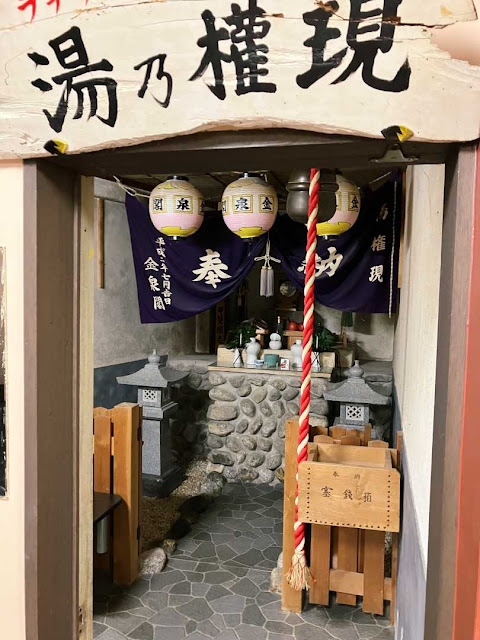Continuing our walk down the pleasant river valley, we arrive at Masutomi just before the sun dips below the ridge. A mini-truck proclaiming the Mizugaki Hunting Club (in English) is parked outside our ryokan’s entrance. Perhaps that explains why our host looks more rugged and tanned than most people who spend their time behind a hotel reception desk.
While signing in, I’m reminded that Masutomi distinguishes itself as a “Radium Onsen”. In Japan, this has been a thing for quite a while, it seems. Visiting Nakabusa Onsen in August 1914, the mountaineering missionary Walter Weston heard his host reporting “With immense pride … that one of the hot springs had been found by a government analyst to contain traces of radium.” Yet Nakabusa was only following where Tokyo led: a year before, a “Radium Institute” spa had opened in the Ginza, complete with a Madame Curie Café.
A sadder and a wiser century later, one might expect that folk would be more circumspect about their geiger count. Yet, if the Wall Street Journal is to be believed, the Fukushima meltdown did nothing to quench the popularity of radioactive hot springs in Japan. Which is presumably why one of Masutomi’s peer resorts still lays claim to “one of the most radioactive springs in the world”, one that “purifies the bod where the legend of the white wolf remains”.
Only a hot investigation can resolve this apparent paradox. After changing into the provided yukatas, the Sensei and I shuffle off to our respective baths. On the way, I notice a shrine to the “gongen” of the waters – surely an unusual feature in a ryokan. All the more intrigued, I proceed into the changing room and drop my yukata in a wicker basket.
Half-expecting to see the blue glow of Cherenkov radiation, I slide open the glass door to the baths. Anticlimatically, there is only a large pool, its water slightly turbid with a whitish silt and, beside it, a small pool of quite ordinary clear water. Since a geezer is already soaking meditatively in the large one, towel neatly folded on top of his head, I opt for the smaller one. This proving to be pleasantly warm, I zone out for a while, towel on head, hoping that it will at least moderate the flow of fast neutrons.
Back in our room, the Sensei and I compare notes. The water was tepid, she says, and it says you have to sit in it for half an hour to get any benefit. What do you mean, I ask – my pool was quite nicely warm … Then you were in the wrong pool, the Sensei declares: didn’t you read the notice explaining that the large pool was the one with radium in it?
Maitta na, I exclaim to myself, as my hot investigation collapses into a heap of methodological rubble. A gentle knock on the door interrupts the conversation, and the ryokan’s maid – seemingly its only staff member – brings in the supper trays. Washed down with a bottle of Kirin, the simple but tasty fare promises to set us up for an excellent night’s sleep, the river murmuring to us from beneath the window. After a long day, this will be a remarkably curative evening after all ….
28 March: waiting for the train home at Nirasaki, we have a panoramic view over the town from the platform. But a thick layer of low cloud hides our mountain of yesterday. Never mind, the first swallows are flitting to and fro over the rooftops. Spring has come.
Maitta na, I exclaim to myself, as my hot investigation collapses into a heap of methodological rubble. A gentle knock on the door interrupts the conversation, and the ryokan’s maid – seemingly its only staff member – brings in the supper trays. Washed down with a bottle of Kirin, the simple but tasty fare promises to set us up for an excellent night’s sleep, the river murmuring to us from beneath the window. After a long day, this will be a remarkably curative evening after all ….
28 March: waiting for the train home at Nirasaki, we have a panoramic view over the town from the platform. But a thick layer of low cloud hides our mountain of yesterday. Never mind, the first swallows are flitting to and fro over the rooftops. Spring has come.











































